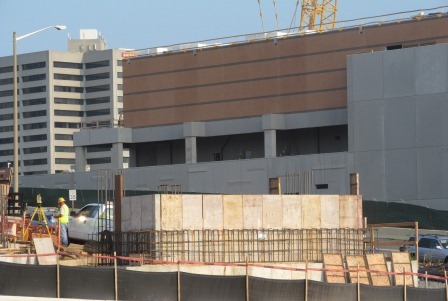 I originally wanted to espouse the benefits of the Silver Line and mixed-use development for my second post, but I henceforth spare you from such shameless propaganda. Sitting in my cubicle on a Friday afternoon in late June, I long for the day when I too end the work week golfing with potential clients instead of pestering secretaries to connect me to CEO’s who just stepped out of the office. Meanwhile, my junior associate will be the one halfway through one-hundred very unsuccessful dials and his fourth coffee. I love my job, but this passion is predicated on expected returns. Furthermore, the dividends of my current struggle are inextricably linked to Fairfax County’s proposed development plans. Has this glaring bias blinded me from all contrarian arguments?
I originally wanted to espouse the benefits of the Silver Line and mixed-use development for my second post, but I henceforth spare you from such shameless propaganda. Sitting in my cubicle on a Friday afternoon in late June, I long for the day when I too end the work week golfing with potential clients instead of pestering secretaries to connect me to CEO’s who just stepped out of the office. Meanwhile, my junior associate will be the one halfway through one-hundred very unsuccessful dials and his fourth coffee. I love my job, but this passion is predicated on expected returns. Furthermore, the dividends of my current struggle are inextricably linked to Fairfax County’s proposed development plans. Has this glaring bias blinded me from all contrarian arguments?
 The biggest drawback is price, a figure that is both astronomical and enigmatic. Quadrupling the size of a congested corporate/retail hub into a cohesive, 24-hour metropolis is not a cheap gamble. Any Galleria shopper hopped up on skinny vanilla latte would think twice before buying this exclusive brand of urbanization. Residents will pay higher taxes for awful traffic exacerbated by never-ending construction. Many of these people will not live to reap the benefits of what they paid for. The plan also emphasizes the importance of a walkable environment while the proposed infrastructure will not alleviate increased traffic to and from the area. The future plight of McLean and Vienna residents exemplify the notable collateral damage to surrounding communities. Fairfax County will no doubt have to beef up transportation infrastructure outside of Tysons as well.
The biggest drawback is price, a figure that is both astronomical and enigmatic. Quadrupling the size of a congested corporate/retail hub into a cohesive, 24-hour metropolis is not a cheap gamble. Any Galleria shopper hopped up on skinny vanilla latte would think twice before buying this exclusive brand of urbanization. Residents will pay higher taxes for awful traffic exacerbated by never-ending construction. Many of these people will not live to reap the benefits of what they paid for. The plan also emphasizes the importance of a walkable environment while the proposed infrastructure will not alleviate increased traffic to and from the area. The future plight of McLean and Vienna residents exemplify the notable collateral damage to surrounding communities. Fairfax County will no doubt have to beef up transportation infrastructure outside of Tysons as well.
 As I researched the impending wave of transit-oriented, mixed-use development (experts have adjusted their annual delivery projections from 700,000 to over 2,000,000 SF due to the influx of seventeen current rezoning applications), this post morphed into a reality check. I never thought that new office buildings, residential towers, and retail shops would necessitate more schools, additional police and fire stations, another electrical substation, and countless other additions to public infrastructure. The logistics of these necessities are frightening. If we want wider sidewalks to increase walkability, what should the ratio of sidewalk to street area be for a “Boulevard Streetscape” as opposed to an avenue or local street? Better yet what constitutes a “Boulevard Streetscape”?
As I researched the impending wave of transit-oriented, mixed-use development (experts have adjusted their annual delivery projections from 700,000 to over 2,000,000 SF due to the influx of seventeen current rezoning applications), this post morphed into a reality check. I never thought that new office buildings, residential towers, and retail shops would necessitate more schools, additional police and fire stations, another electrical substation, and countless other additions to public infrastructure. The logistics of these necessities are frightening. If we want wider sidewalks to increase walkability, what should the ratio of sidewalk to street area be for a “Boulevard Streetscape” as opposed to an avenue or local street? Better yet what constitutes a “Boulevard Streetscape”?

Bureaucracies evolved to establish this type of necessary order in rapidly growing societies. The utter frustration of waiting at the DMV is an opportunity cost. Alternatives to the cruel and unusual anticipation of hearing number B219 over the loudspeaker at your local DMV are stagnation, chaos, and a more conscientious application of the Eight Amendment by our Supreme Court. Fairfax County is thriving when much of the world is teetering on the brink of another recession.

The Dulles Toll Road is at the forefront of the tech industry second only to Silicon Valley; the federal government is a unique impetus to our local economy. Opportunity is attracting jobseekers and amplifying population growth. Tysons Corner has 18,000 residents and 100,000 jobs. Fairfax County’s plan estimates that Tysons will have 100,000 residents and 200,000 jobs by 2050. Yes, more people will be driving to Tysons, but this is inevitable. Mixed-use, high-density development ensures that a much greater percentage of residents will live and work here reducing per capita stress on public infrastructure. Our future necessitates a new approach to development.

